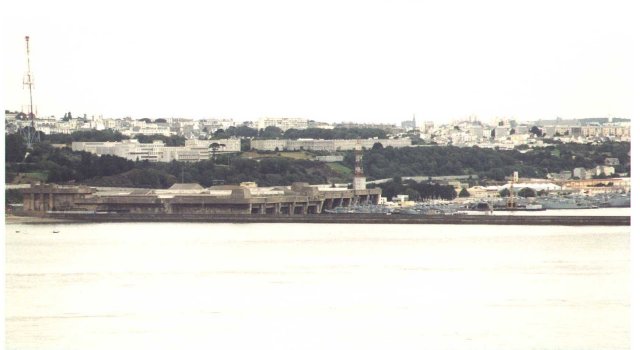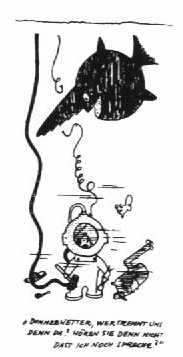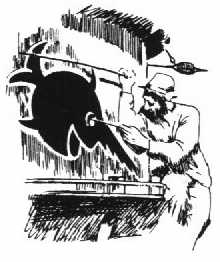| Main Members Actual story Map of Brest Scoreboard U-boat Gallery More U-Units Very special Flotilla History Sources |
Here you will find historical data about the Base
of Brest and the 9th. Flotilla.The third
paragraph is the story of the birth of the flotilla
insignia. The French port at Brest was occupied on 18 June, 1940 by the German 5. Panzerdivision (5th Panzer Division). English troops had destroyed most of the harbour facilities prior to the occupation. The first German U-boat to use the Brest harbour was U-65, which arrived on 22 August, 1940 and stayed here for 5 days for some repairs. The harbour facilities at Brest were restored to full working order on September 15, 1940 and preparations for full U-boat deployment began immediately thereafter. The 1st flotilla moved from Kiel to Brest in June 1941 and the first boat reaching the new base was U-204 on the 27th June 1941. Also the 9th flotilla was established there in October 1941. The building of the U-boat bunker started in January 1941 and in September 1941 the first boat, U-372 used the first ready pen. The U-boat bunker at Brest was 333 meters wide, 192 meters long and roughly 17 meters high. The area covered was a record 52,000 square meters. The bunker was actually two structures, the first consisting of 13 pens, A to E and 1 to 8, the second of pens 9 and 10. The thickness of the roof was 3.6m in the first structure and 4.3 above pens 9 and 10. A second layer of concrete was poured over most of the roof increasing the thickness to 6.2 meters.
The RAF (and from 1943, the USAAF) attacked the base and the bunker over 80 times since January 1941 and lost more than 50 aircraft during those attacks. But the first successes against the bunker finally came during August 1944, when the RAF (617th Squadron) attacked the bunker at Brest using Lancasters that carried 12,000 pound Tallboy bombs (6,4 meter length). The attacks came on August 5, 12 and 13 and all in all 26 aircraft dropped one such bomb at each bunker, scoring 9 direct hits and a few near-misses. Of those only 5 actually penetrated the massive roof and caused surprisingly little damage inside the bunker and none to the U-boats there. The last U-boat to leave Brest was U-256 which had been repaired hastily and was commanded by the Flotilla Commander, Korvkpt. Lehmann-Willenbrock which took the boat out from Brest on 4 Sept and managed to bring the boat the Bergen, Norway on 17 October. Both Flotillas were disbanded in September and thus all U-boat activity ceased at the base. Brest was captured by the allied forced on September 21, 1944 after a fierce month-long battle which caused US forces over 10,000 causalities and almost wiped out the entire town. Brest is still a submarine base, now serving the French Navy of course, and the bunker is still in use today
The 9th flotilla started service in Oktober 1941 and was operational
until September 1944. The boats operating from there were typ VIIC, VIIC/41 and VIID. The following 84 U-boats were assigned during the service of the flotilla: The 9th flotilla was founded during the autumn of 1941. After some preparations U-213 was the first boat which reached Brest on 20 March, 1942, and attached to the flotilla in April 1942.
In August/September 1944 most of the boats left the base for Norway.
The last flotilla boat was U-256, which left Brest on 4 Sept, 1944 under
the command of Korvkpt. Heinrich Lehmann-Willenbrock and reached on 17 Oct
1944 Bergen (Norway). That journey also marked the end of the flotilla.
The laughing Sawfish is the personal insignia of Korvkpt. Heinrich
Lehmann-Willenbrock for his u-boat U-96.
The artist named Kossatz, a friend of Lehmann-Willenbrock painted
the fish on the U-boat, originally in green.
When Lehmann-Willenbrock took over command of the 9th. Flotilla the
Laughing Sawfish was assigned as flotilla insignia. Here is a collection of pictures from U 96 with focus on the emblem. To enlarge the pictures just click on the thumbnail.
Return to top of page
During the war, the german U-boats encountered a lot of ships from
various nations. The commander had to check if he was allowed to attack the
target or not. This was depending on the area he sighted the ship and in
which period of the war he was.
It has to be taken in notice, that the Third Reich has declared the total blockade of the british islands from the 17.08.1940 on. Which means that every ship trying to reach british ports could be attacked without a warning. The naval units of the german Luftwaffe
One of the reasons why the german u-boats suffered so heavy losses
was their vulnerability to air attacks. |












